 By Bob Currie, Recreational Boating Safety Specialist
By Bob Currie, Recreational Boating Safety Specialist
U. S. Coast Guard Auxiliary Station Galveston Flotilla.
US Coast Guard Sector Houston-Galveston received reports of distress signal flares being sent up on two separate occasions this month. They turned out to be false distress signals. One distress signal was sent up in Dickinson Bay and the other off Kemah in Galveston Bay. The cost of investigating distress signals is well-established. It costs $10,000 an hour for the Coast Guard to respond to distress signals. The time and resources used for false distress signals could delay a response to a legitimate maritime emergency in a different location. Flares are an internationally-recognized distress signal and are designed to draw attention to an emergency situation. Lighting flares from vessels will activate a response from the USCG, which may pull resources away from those in actual distress.
The Station Galveston Flotilla of the US Coast Guard Auxiliary operates out of the USCG Station Galveston base on Galveston Island. They aid the Coast Guard by providing maritime observation patrols in Galveston Bay; by providing recreational boating vessel safety checks; and by working alongside Coast Guard members in maritime accident investigation, small boat training, providing a safety zone, Aids to Navigation verification, in the galley, and on the Coast Guard Drone Team.
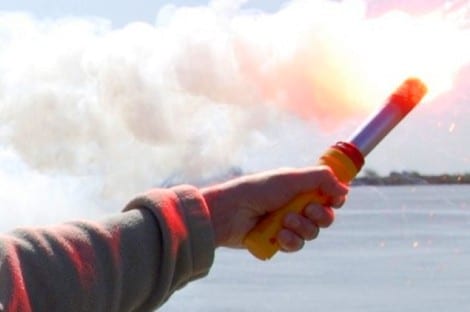
File image courtesy of USCG
False Distress Signals
It is a federal felony for anyone to intentionally communicate a false distress message to the Coast Guard or cause the Coast Guard to attempt to save lives and property when no help is needed. This includes firing flares in a non-distress situation or using the word “mayday” for a radio check. This felony offense is punishable by up to ten years in prison, a criminal fine of up to $250,000, a civil fine of up to $10,000, and reimbursement to the Coast Guard for the cost of any search effort resulting from the false signal.
USCG-Required Visual Distress Signals
U.S. Coast Guard regulations require that vessels operating on coastal waters of the United States, the Great Lakes, and territorial seas, as well as those inland waters connected directly to coastal waters, the Great Lakes, and territorial seas from the point of connection to the point at which the waterway narrows to less than two nautical miles wide, must be equipped with U.S. Coast Guard approved visual distress signals. Recreational boats 16 feet and over are required to carry the following working and unexpired (if expiration is shown) visual distress signals:
- Three day and three night pyrotechnic devices,
- One day non-pyrotechnic device (flag) and one night non-pyrotechnic device (auto SOS light), or
- A combination of 1) and 2); Example: One flag and three night pyrotechnic devices
Recreational boats less than 16 feet on coastal waters or the Great Lakes need only carry night visual distress signals when operating from sunset to sunrise. Texas has no further requirements than those required by the Coast Guard. When purchasing pyrotechnic devices, note that some such devices, such as orange smoke devices, are for daytime use only, and thus only meet the daytime requirement of the regulation.
It is recommended, but not required, that boats operating on inland waters should have some means of making a suitable day and night visual distress signal. The number and type of signals is best judged by considering conditions under which the boat will be operating.
The following vessels are not required to carry day signals, but must carry night signals when operating from sunset to sunrise:
- Recreational boats less than 16 feet in length.
- A vessel participating in any organized marine parade, regatta, race, or similar event.
- A manually propelled boat.
- Sailboats less than 26 feet of completely open construction and not equipped with propulsion machinery.
Proper Use of an Emergency Signal Flare
Emergency signal flares can be quite dangerous if not handled properly. People have burned their boats to the water line by improperly handling a lit flare. You should not light an emergency signal flare until you have another boat in sight. Lighting one with no one available to see the signal is a waste of time. You should only light a handheld signal flare when there is another vessel in sight.
Here is how to properly use an emergency signal flare:
- Hold by the end indicated
- Remove lid or cap
- Use striker and cap to ignite
- Hold burning flare over side of boat and aim downwind
- Do not wave overhead
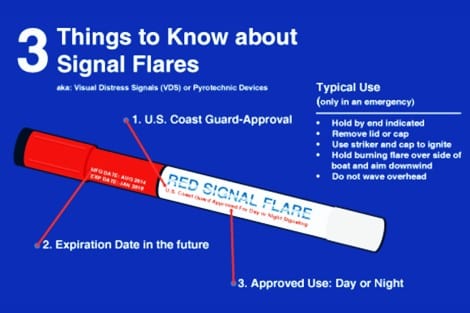
And the Rockets’ Red Glare . . .
Meteor flares are propelled by black powder and launched from a pistol-shaped handheld holder. They reach an altitude of 375′ to 500′ and burn for 7-8 seconds. Rocket-propelled SOLAS parachute flares rise to 1,000′ and burn for 40 seconds. Fire aerial flares after you have sighted or heard a potential rescue vessel. To attract their attention to your distress situation, the U.S. Coast Guard recommends that you fire two aerial flares – one immediately after the other – so rescuers can confirm the sighting and the direction of the signal.
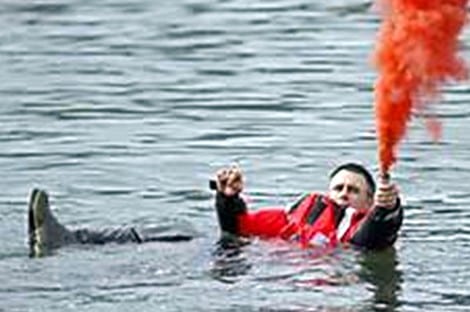
Smoke Flare- Image courtesy of USCG
Handheld flares burn for one to two minutes and are for both daytime and nighttime use. Orange SOLAS smoke flares are for daytime use only and are the best way for offshore boaters to show their location to rescuers searching in a Coast Guard helicopter or fixed wing aircraft. They float on the water’s surface and emit a dense orange cloud for three to four minutes. Handheld signal flares are intended as homing signals to pinpoint your position. The surface-to-surface sighting range on water is approximately three to five miles, depending on boat elevation. If a rescuer is five miles away and running at 20 miles per hour, it will take 15 minutes to reach you. Therefore, you should have at least 12 minutes (total burn time) of signals onboard to maintain a strong homing signal until help arrives.
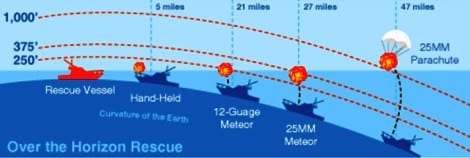
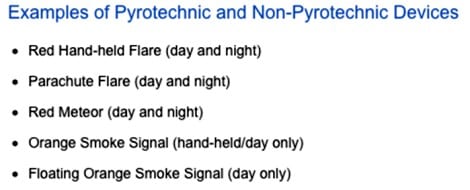
Summary
Know when and how to display an emergency signal flare. It could save your life.
For more information on boating safety, please visit the Official Website of the U.S. Coast Guard’s Boating Safety Division at www.uscgboating.org. Questions about the US Coast Guard Auxiliary or our free Vessel Safety Check program may be directed to me at [email protected]. SAFE BOATING!
[Oct-19-2020]

 Posted in
Posted in 
























